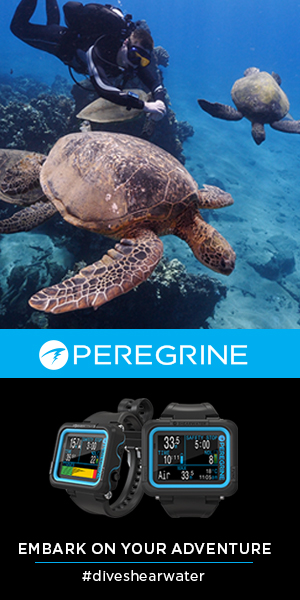Mentioning the word “Florida” evokes thoughts of white-sand beaches, turquoise water and a warm, tropical climate. Vacationers come by the millions to enjoy its many attractions, including an enormously popular string of islands known as the Florida Keys. Stretching over 120 miles (192 km) in length, the islands dot the southernmost end of Florida, welcoming visitors from around the world to immerse themselves in this “come as you are” vacation destination. Art, entertainment, music and museums are available throughout the Keys. Watersports such as scuba, snorkeling and fishing are also exciting possibilities.
Early History
The original inhabitants were the Calusa people, whose numbers dwindled after the 1513 arrival of explorer Ponce de Leon, who claimed it for the Spanish empire. Multiple settlement attempts by various Native American groups and by Spain, France and Great Britain started — and struggled — during the next few hundred years. Florida was under colonial rule by Spain and Great Britain during the 18th and 19th centuries before becoming a U.S. territory in 1822. Florida gained statehood in 1845.
Pineapple plantations flourished in the late 1800s and early 1900s. The production of Florida’s famous Key limes soon followed. In the 1820s, the U.S. government encouraged expansion in the South and began a homestead program on the Keys in the mid-1880s. Key West became the first settlement. The rest of the island chain remained deserted until Fort Zachary Taylor was built in Key West by the United States. The fort served as an army base until the 1990s.
In 1905, Henry Flagler, entrepreneur and co-founder of Standard Oil, began the huge task of extending the Florida East Coast Railway from Key Largo to Key West. After seven difficult years of battling storms, diseases and workers’ deaths, the railroad was completed in 1912. Unfortunately, the intense Hurricane of 1935 destroyed the settlements as well as the railroad. The development of a pipeline through the islands in 1942 brought new life to the Keys. Soon the government began promoting the Keys as a vacation destination, leading to modern development and the growth of tourism, the island’s main commodity. Tourism continues to mushroom as visitors come for an enjoyable vacation in the surf and sun.
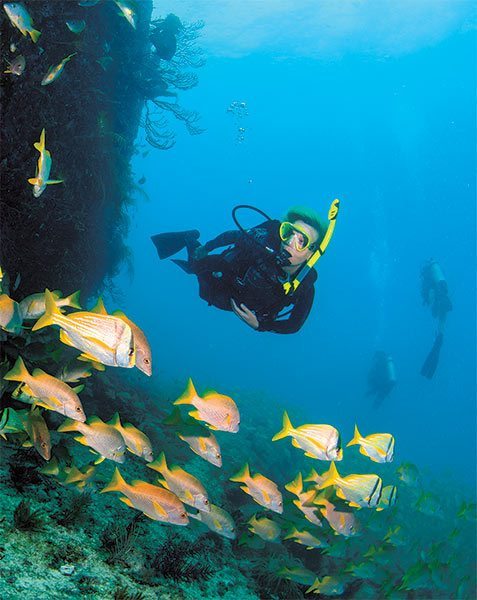
A World Away From The Ordinary
The islands of the Florida Keys form a tropical coral archipelago stretching from the eastern tip of the Florida peninsula to the Dry Tortugas in the Gulf of Mexico. The peninsula serves as a barrier between the Atlantic and the Gulf of Mexico. Key Largo, located at the northern end of the Keys, is considered the gateway to the continent. Key Largo is also the largest island, measuring 29 miles (46 km) long and less than two miles (3.2 km) wide. The famous island of Key West, located on the southern end, is the smallest island, less than four miles (6.4 km) long and two miles (3.2 km) wide. Key West is the westernmost island in the Keys and is also the southernmost point of the U.S. mainland. Because the islands are strung out in a long, narrow band and tend to be relatively flat, visitors can frequently enjoy brilliant sunrises and glowing sunsets without changing locations.
Until construction of the railway, the Florida Keys were only reachable by boat. Today is very different. The islands are more like stepping stones connected by a series of bridges and causeways along U.S. 1. Included is the Seven Mile Bridge, an engineering marvel that connects the middle and lower Keys.
Various cultures are represented in the islands, including people from neighboring Cuba and the Bahamas. Many Americans have also chosen to retire in the Keys. After all, there are very few “drive to” tropical islands that offer easy accessibility, modern conveniences and year-round entertainment. The islands also offer a rich history in culture and the arts. Renowned writers like Ernest Hemingway and Tennessee Williams made their homes in the Keys, where they wrote some of their best novels.
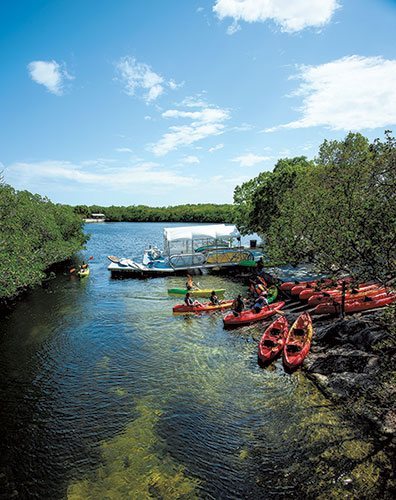
John Pennekamp State Park offers many options, including kayaking, canoeing and paddleboarding.
Follow The Overseas Highway
Key Largo is a premier location for watersports, such as diving, kayaking and sport fishing. Two state parks and one national park are on the island, including John Pennekamp State Park, Dagny Johnson Key Largo Hammock Botanical State Park and the Everglades National Park, respectively. A canal system winding its way to the ocean is lined with picturesque homes and boat docks. For a unique adventure on the canal, visitors can step back in time by hopping on the original, refurbished African Queen that carried Kathryn Hepburn and Humphrey Bogart to stardom.
Considered the heart of the Florida Keys, Marathon is the next major town on U.S. Highway 1. Marathon is a quaint town, reflecting the old Keys lifestyle. A seafood festival honoring seafaring traditions is held annually, providing entertainment for the whole family. U.S. 1 takes travelers through the Lower Keys and Big Pine Key on the way to Key West. Brilliant blue skies, palm-lined streets and balmy weather provide a stunning backdrop for strolling through shop-lined streets, playing a round of golf at the Key West Golf Club or diving into the deep blue.
A variety of watersports adventures can be arranged by visiting the Historic Seaport District, including a ferry trip to the Dry Tortugas National Park.
Key West presents a carnival-like atmosphere during the day when streets come alive with performances by jugglers, mimes and street artists. As the sun sinks below the horizon, charming sidewalk cafes, world-class restaurants and open-air bars are the place to be.
Key West is also home to the Florida Keys Community College, with additional campuses in Key Largo and Marathon. Since the campuses are located within the Florida Keys National Marine Sanctuary, an important part of the curriculum involves studies in marine environment.
Seafood is predominant when it comes to island cuisine, but remember to save room for Florida’s famous key lime pie, the perfect ending to any meal.
Accommodations to suit every taste are available throughout the Keys, including campgrounds, condos, upscale waterfront hotels and all-inclusive resorts.
Green — The New Gold
For more than a century the Florida government has given top priority to the conservation and preservation of its outstanding natural resources above and below the ocean’s surface. In 1963, America’s first underwater marine reserve was established in Florida. A Miami newspaper columnist, John Pennekamp, wrote a series of articles stressing the need for conserving the coral reefs and marine environment. His work led to the establishment of the John Pennekamp State Park. The park continues to welcome more than a million visitors every year. Preservation efforts continued with the development of the Key Largo National Marine Sanctuary in 1975. The Looe Key National Marine Sanctuary was founded six years later to protect the superb Lower Keys reef.
When the U.S. government established the Florida Keys National Marine Sanctuary (FKNMS) in 1990, conservation took a giant leap forward. The sanctuary surrounds the Keys and includes huge areas of the Atlantic Ocean, the Gulf of Mexico and Florida Bay. Special areas are designated as marine nurseries and no-take refuges.
One of the most fascinating reserves is the Dry Tortugas National Park. This remote reserve is 70 miles (112 km) west of Key West in the Gulf of Mexico. Reachable only by private boats or ferries, the park contains the largest no-take marine reserve in the continental United States.
The Coral Restoration Foundation (CRF) is one of the newest and most exciting preservation efforts in the Keys. Founded by Ken Nedimyer who grew up diving in the Keys, the CRF’s main goal is the restoration of elkhorn and staghorn coral on the reefs.
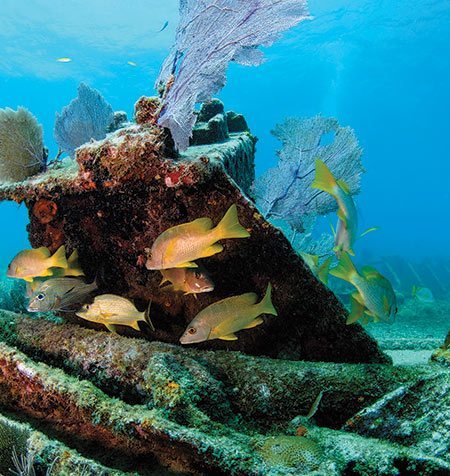
Divers come by the thousands to experience clear water, colorful varieties of marine life and intriguing shipwrecks.
Diving The Barrier Reef
The Keys are extremely fortunate to be home to the United States’ only living coral barrier reef, the third-largest reef in the world. The reef runs parallel to the Keys less than 10 miles (16 km) offshore. Divers come by the thousands to experience clear water, colorful varieties of marine life and intriguing shipwrecks. Tropical fish, green moray eels, striped grunts and occasional deepwater pelagics are found here. Coral-encrusted shipwrecks provide excellent homes for marine life and eerie structures for curious divers to explore.
Shipwrecks sunk as artificial reefs and historical ships sunk by raging storms have become a haven for divers with a passion for wreck diving. Shipwreck Trail, made up of world-class wrecks, begins off Key Largo where the wreck of the Spiegel Grove rests 130 feet (39 m) below the surface. The 510-foot (155 m) retired Navy ship was intentionally sunk in 2002 to create an artificial reef.
The latest addition to Shipwreck Trail is the USNS Gen. Hoyt S. Vandenberg, sunk seven miles (11 km) south of the Key West International Airport. At a length of 523 feet (158 m), the Vandenberg is the largest artificial reef in the Keys and the second-largest in the world. The top of the ship is open and free of any obstructions, making it a safe, easy dive. The ocean floor at the site is deeper than normal recreational diving depths. However, most of the interesting features are less than 100 feet (30 m) deep.
Shipwreck Trail contains 10 wrecks between Key Largo and Key West. San Pedro is the oldest ship. The Thunderbolt off of Marathon is one of the most popular sites, while the Eagle is Islamorada’s premier wreck. Other well-known wrecks are the Benwood, the Duane and its sister ship, the Bibb, suited for technical divers.
Marine preservation and diver safety are top priorities in the Florida Keys. More than 470 mooring lines and buoys, maintained by the FKNMS, mark dive sites, artificial reefs and sanctuary preservations in the area. In addition, dive boats and captains are certified by the U.S. Coast Guard to provide optimal safety. The Blue Star program, also established by the FKNMS, is a voluntary, nonregulatory program that recognizes dive operators for their dedication and commitment to responsible and sustainable snorkeling and dive practices. The program also encourages responsible tourism by teaching reef etiquette and good buoyancy to lessen human impact on the reef.
Kaleidoscope Of Entertainment
Visitors of all ages will discover entertaining activities throughout the Keys. Of course, watersports are especially popular. John Pennekamp State Park offers many options, including kayaking, canoeing and paddleboarding. Parasailing over the glistening turquoise water is certainly exhilarating, and kiteboarding offers a fun way to skip across the ocean. Snorkeling gives visitors a peek into the incredible world beneath the ocean’s surface. For avid fishermen, world-class fishing tournaments and bonefishing along the Atlantic shallows are always a thrill. Flanked by the Everglades National Park, Key Largo is a prime location for eco-tourists who enjoy birding and hiking along beautiful nature trails.
Mile markers guide the way to a variety of attractions along the famous Overseas Highway. Art galleries are plentiful. Theaters such as the Tennessee Williams Theatre feature professional and local performers presenting comedies, dramas and children’s shows. The Upper Keys Concert Series and the Islamorada Center stage uplifting musical performances for entertainment. The Key West Craft Show always draws a crowd when two Old Town streets are converted to an open-air gallery filled with creative, unique arts and crafts. In Islamorada, the Morada Way Arts and Culture District has numerous eclectic galleries offering very affordable, enchanting items for sale. Performing arts are enormously popular throughout the Keys.
A stroll through the Key West Tropical Forest and Botanical Garden offers a change of pace for visitors. Many rare birds as well as endangered flora and fauna are on display for everyone’s enjoyment.
Literature enthusiasts will enjoy a visit to the Ernest Hemingway Home and Museum. Hemingway lived in the Keys for a decade, producing some of his finest works during that period. Scuba divers will especially find the Florida Keys History of Diving Museum interesting. Located in the Upper Keys, the museum’s main goal is collecting and preserving amazing artifacts, photos and antiques that reflect the heritage of diving. For nature lovers, visit Marathon’s Crane Point Museum, Nature Center and Historic Site. The 64-acre (26 hectare) tropical grounds contain a wild bird rehab center, large hardwood trees and enjoyable nature trails. This area is one of the most historical sites in the Keys.
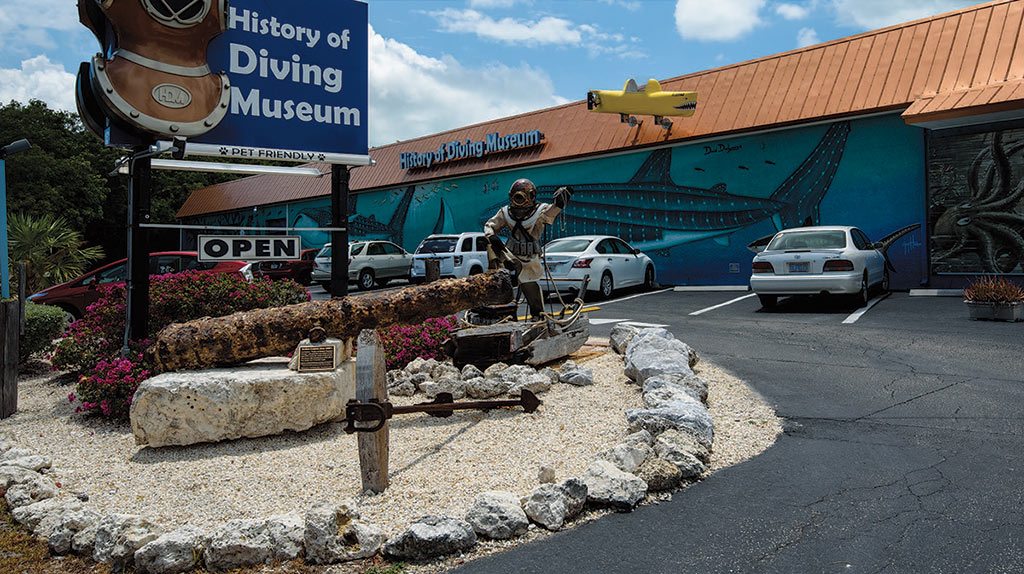
Scuba divers will enjoy visiting the Florida Keys History of Diving Museum.
Festivals, Festivals, Festivals
Numerous festivals are held throughout the year, providing whimsical entertainment for locals and vacationers. One of the most popular events is the Key West Lobsterfest, which marks the beginning of lobster season. Live music, fun activities and succulent fresh lobster are a special part of the event. Anticipation fills the air at the Key West Historic Seaport Music Festival when concerts and other musical events take the stage. Everyone in attendance will enjoy delicious food and beverages as they dance to the rhythm of island music. In mid-November, the Old Island Days Art Festival ushers in the celebration of Key West’s culture and heritage. Home and garden tours, craft shows and a conch shell blowing contest are just part of the activities. The Pigeon Key Art Festival will celebrate its 21st year in 2015. Held under the old Seven Mile Bridge, the arts and crafts show celebrates the heritage of the tiny town of Pigeon Key. Numerous musicians from the islands provide entertainment during the festivities.
It is easy to understand why the Keys are often called the American Caribbean. Mother Nature and man have created an amazing tropical destination with vibrant communities overflowing with talent and entertaining attractions. No wonder visitors from around the world are drawn to these amazing little islands known as the Florida Keys.
Story and photos by Ruth and Barry Guimbellot






